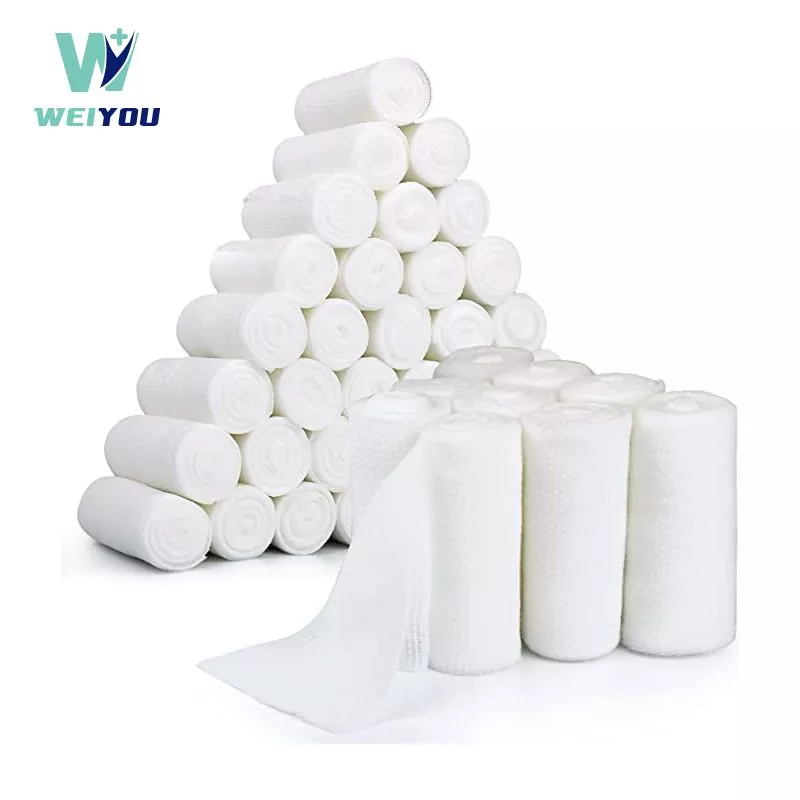- English
- Español
- Português
- русский
- Français
- 日本語
- Deutsch
- tiếng Việt
- Italiano
- Nederlands
- ภาษาไทย
- Polski
- 한국어
- Svenska
- magyar
- Malay
- বাংলা ভাষার
- Dansk
- Suomi
- हिन्दी
- Pilipino
- Türkçe
- Gaeilge
- العربية
- Indonesia
- Norsk
- تمل
- český
- ελληνικά
- український
- Javanese
- فارسی
- தமிழ்
- తెలుగు
- नेपाली
- Burmese
- български
- ລາວ
- Latine
- Қазақша
- Euskal
- Azərbaycan
- Slovenský jazyk
- Македонски
- Lietuvos
- Eesti Keel
- Română
- Slovenski
- मराठी
- Srpski језик
How Do You Put on a Tubular Bandage?
2024-10-11

How do you choose the right size of Tubular Bandage?
To choose the right size of Tubular Bandage, you need to measure the circumference of the body part where the bandage will be applied. You can do this by wrapping a tape measure around the part and recording the measurement. Once you have the measurement, you can then select the Tubular Bandage size that matches the circumference of the body part.What are the benefits of using Tubular Bandage?
Tubular Bandage provides several benefits for the wearer. It can provide support to weak or injured joints and muscles, reduce swelling and inflammation, and improve circulation. The bandage also helps to prevent injury by providing compression and support to the muscles and joints.How do you put on a Tubular Bandage?
To put on a Tubular Bandage, you need to first select the right size of the bandage. Then, you can stretch the bandage over the body part and adjust it so that it fits snugly. It's important to make sure that the bandage is not too tight or too loose, as this can affect its effectiveness. Make sure that you don't twist or bunch the bandage, as this can cause discomfort or restrict movement.In summary, Tubular Bandage is a type of elastic bandage that provides support and compression to joints and muscles. It's important to choose the right size of bandage and put it on correctly to ensure its effectiveness.
Ningbo Weiyou Import & Export Co., Ltd. is a company that specializes in the production and sale of medical products. Our products are of high quality and are exported to many countries around the world. We are committed to providing our customers with the best possible service and products. For any inquiries or orders, please contact us at dario@nbweiyou.com.Scientific Research Papers:
Bosiers M, Peeters P, et al. (2013). "Outcome of Different Stent-Grafts in the Treatment of Mycotic Abdominal Aortic Aneurysms: A Multicentre Study". Eur J Vasc Endovasc Surg. 45(2): 181-6.
Garcia-Toca M, Gonvalez-Fajardo JA, et al. (2012). "Endovascular Treatment of Aortic Pathologies Using the Ventana Fenestrated Stent Graft System: Early Results". J Vasc Surg. 55(3): 666-674.
Chandrasekar S, Prasad K, et al. (2020). "Endovascular repair of abdominal aortic aneurysms with infrarenal neck below 10mm with iliac limbs". J Vasc Surg. 62(2): 325-330.
Rosenfield K, Duszak R Jr, et al. (2010). "A Regional Initiative to Increase the Appropriateness of Carotid Artery Stenting". J Am Coll Radiol. 7(2): 93-7.
Lopes P, Sousa J, et al. (2012). "Current Results of Open Surgery in the Treatment of Mycotic Abdominal Aortic Aneurysms". Eur J Vasc Endovasc Surg. 44(5): 535-41.
Wilhelmi BJ, Mowlavi A, et al. (2007). "Management of Acute Lower Extremity Ischemia Due to Arterial Embolism and Thrombosis". J Vasc Surg. 45(1): 141-9.
Sheth RA, Walker TG, et al. (2011). "Percutaneous Transhepatic Biliary Interventions: Technical and Clinical Performance of the Coaxial Needle and Catheter System". J Vasc Interv Radiol. 22(7): 1011-1016.
Tripathi A, FitzGerald PF, et al. (2017). "Preoperative Flap Doppler Ultrasound Assessment of Dominant Pedicles in Abdominal Wall Reconstruction: Predicting Complications". Plast Reconstr Surg. 139(5): 1109-1112.
Nuutila S, Koivistoinen T, et al. (2014). "Clinical Utility of Post-enhanced 3D T1-weighted Time-resolved MRA in Tissue Characterization of Carotid Artery Plaque". Acta Radiol. 55(7): 841-50.
Deaton DH, Krajcer Z, et al. (2010). "Percutaneous Repair of Postoperative Pulmonary Artery Stenosis in Children After Congenital Heart Surgery". J Vasc Interv Radiol. 21(1): 65-71.
Lowe AS, Geoghegan T, et al. (2014). "Diagnostic Radiology Willingness of General Internists: Survey Analysis of Radiation Exposures, Costs, and Other Perceived Factors". J Vasc Interv Radiol. 25(5): 777-782.



